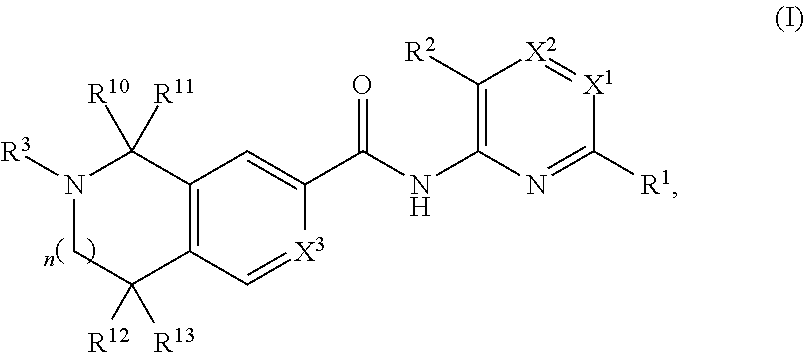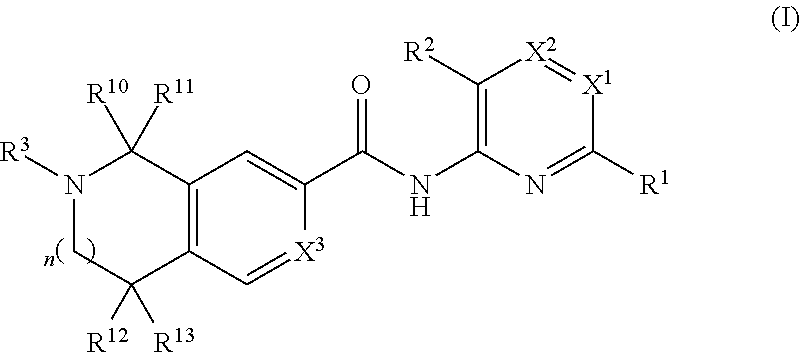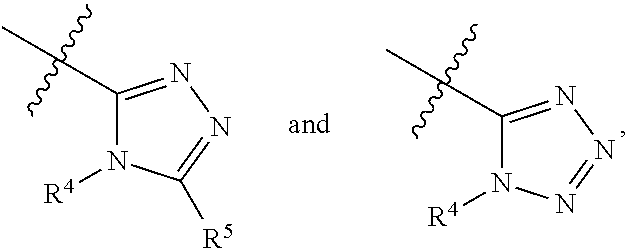Apoptosis signal-regulating kinase 1 inhibitors and methods of use thereof
a signal-regulating kinase and kinase technology, applied in the field of compounds and pharmaceutical compositions useful as ask1 inhibitors, can solve problems such as fat accumulation and fatty acid oxidation, and achieve the effect of prevention or treatmen
- Summary
- Abstract
- Description
- Claims
- Application Information
AI Technical Summary
Benefits of technology
Problems solved by technology
Method used
Image
Examples
example 183a
[0222]
Step 4-1
[0223]
[0224]A solution of LiOH (0.22 g, 6.4 mmol, 5.0 eq) in H2O (2.7 mL) was added to a solution of compound (4-5) (300 mg, 1.0 mmol, 1.0 eq) in MeOH (4.0 mL) and the reaction was stirred for 2 hrs. The reaction was partitioned between Et2O and H2O. The layers were separated and the aqueous layer was adjusted to an acidic pH (˜5) with 0.1M aqueous HCl. The resulting mixture was extracted with EtOAc (2×). The combined organic layers were dried (MgSO4), filtered, and concentrated under reduced pressure to afford pure compound (4-6) (286 mg, 1.0 mmol, 100%) as a colorless gum.
Step 4-2
[0225]
[0226]HATU (471 mg, 1.2 mmol, 1.2 eq) was added to a suspension of crude compound (4-6) (286 mg, 1.0 mmol, 1.0 eq) in DMF (2.7 mL). Compound (1-12) (210 mg, 1.0 mmol, 1.0 eq), prepared according to US 2014 / 0018370 and Hunig's base (0.45 mL, 2.6 mmol, 2.5 eq) were added and the reaction was stirred overnight. The reaction was diluted with EtOAc and the organic layer was washed with 10% ...
example 1
of 6-(1-isopropyl-1H-tetrazol-5-yl)pyridin-2-amine
[0227]
Step 1. Synthesis of N-isopropyl-6-nitropicolinamide
[0228]
[0229]To a solution of 6-nitropicolinic acid (10 g, 59.5 mmol) and Hunig's base (31.1 mL, 178 mmol, 3 eq) in dry DMF (200 mL) at 0° C. was added isopropylamine (6.64 mL, 77 mmol, 1.3 eq) followed by HATU (29.4 g, 77 mmol, 1.3 eq). The resulting mixture was allowed to warm to rt and stirred until the starting material was consumed. The reaction was quenched by the addition of water (500 mL). The mixture was extracted with EtOAc (3×200 mL) and the combined organic layers were washed with H2O (2×200 mL), brine (200 mL), dried (Na2SO4) and concentrated under reduced pressure. The resultant residue was purified by SiO2 column chromatography (100% hexanes to 40% EtOAc / Hexanes) to afford N-isopropyl-6-nitropicolinamide (10.81 g, 87% yield) as a light yellow solid: 1H NMR (400 MHz, Chloroform-d) δ 8.58 (dd, J=7.7, 1.0 Hz, 1H), 8.36 (dd, J=8.0, 1.0 Hz, 1H), 8.21 (t, J=7.8 Hz, 1H)...
example 3
of benzyl 5-((6-(4-isopropyl-4H-1,2,4-triazol-3-yl)pyridin-2-yl)carbamoyl)isoindoline-2-carboxylate
[0242]
Step 1. Synthesis of 2-benzyl 5-methyl isoindoline-2,5-dicarboxylate
[0243]
[0244]Benzyl chloroformate (1.0 mL, 7.0 mmol) was added dropwise to a solution of methyl isoindoline-5-carboxylate, hydrochloride (1.0 g, 4.7 mmol), Et3N (1.4 mL, 10.3 mmol), and DMAP (52 mg, 0.43 mmol) in DCM (9.4 mL) at 0° C. The cold bath was removed, and the reaction was stirred for 16 h at rt. The reaction was quenched with sat. NaHCO3 and diluted with CH2Cl2. The layers were separated and the aqueous layer was extracted with CH2Cl2 (2×). The combined organic layers were washed with brine, dried (MgSO4), filtered, and concentrated under reduced pressure. The resultant orange gum was purified by column chromatography eluting with hexanes / EtOAc (0% EtOAc→35% EtOAc) to give 2-benzyl 5-methyl isoindoline-2,5-dicarboxylate (1.4 g, 4.6 mmol, 98% yield) as a pale yellow solid: 1H NMR (400 MHz, DMSO-d6) δ 7.94...
PUM
 Login to View More
Login to View More Abstract
Description
Claims
Application Information
 Login to View More
Login to View More - R&D
- Intellectual Property
- Life Sciences
- Materials
- Tech Scout
- Unparalleled Data Quality
- Higher Quality Content
- 60% Fewer Hallucinations
Browse by: Latest US Patents, China's latest patents, Technical Efficacy Thesaurus, Application Domain, Technology Topic, Popular Technical Reports.
© 2025 PatSnap. All rights reserved.Legal|Privacy policy|Modern Slavery Act Transparency Statement|Sitemap|About US| Contact US: help@patsnap.com



